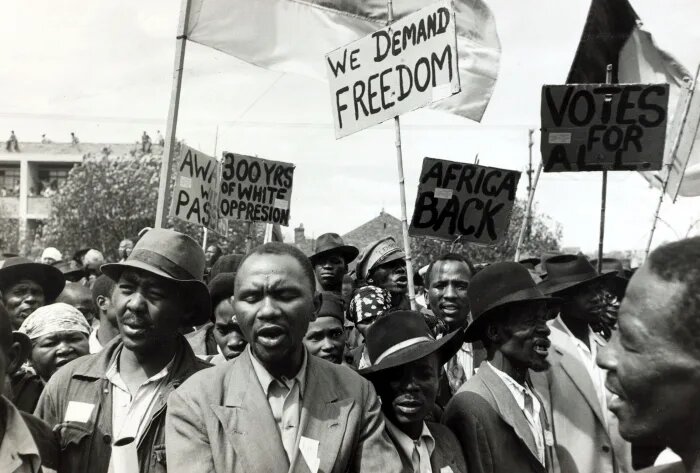For decades, the country’s black majority was controlled by racist laws enshrining white supremacy.
From 1948 through the 1990s, a single word dominated life in South Africa. Apartheid—Afrikaans for “apartness”—kept the country’s majority black population under the thumb of a small white minority. It would take decades of struggle to stop the policy, which affected every facet of life in a country locked in centuries-old patterns of discrimination and racism.
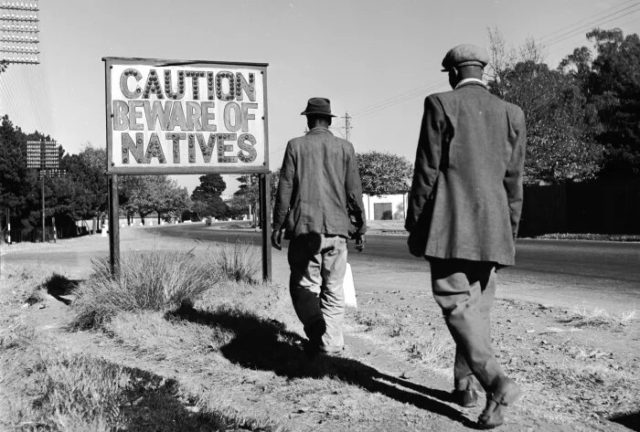
A sign common in Johannesburg, South Africa, reading ‘Caution Beware Of Natives’.
The segregation began in 1948 after the National Party came to power. The nationalist political party instituted policies of white supremacy, which empowered white South Africans who descended from both Dutch and British settlers in South Africa while further disenfranchising black Africans.
The system was rooted in the country’s history of colonization and slavery. White settlers had historically viewed black South Africans as a natural resource to be used to turn the country from a rural society to an industrialized one. Starting in the 17th century, Dutch settlers relied on slaves to build up South Africa. Around the time that slavery was abolished in the country in 1863, gold and diamonds were discovered in South Africa.
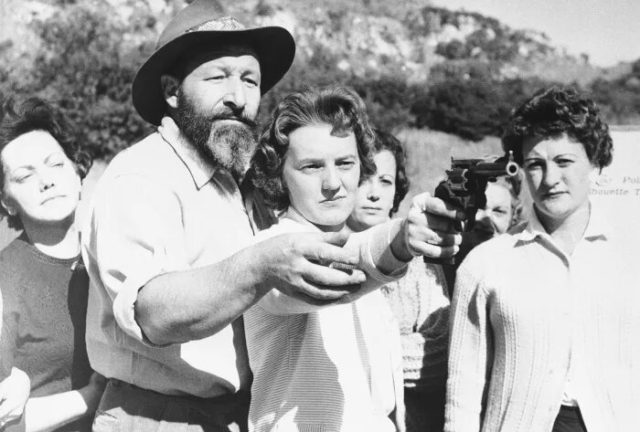
Many white women in South Africa learned how to use firearms for self-protection in the event of racial unrest in 1961, when South Africa became a republic.
That discovery represented a lucrative opportunity for white-owned mining companies that employed—and exploited—black workers. Those companies all but enslaved black miners while enjoying massive wealth from the diamonds and gold they mined. Like Dutch slave holders, they relied on intimidation and discrimination to rule over their black workers.
The mining companies borrowed a tactic that earlier slaveholders and British settlers had used to control black workers: pass laws. As early as the 18th century, these laws had required members of the black majority, and other people of color, to carry identification papers at all times and restricted their movement in certain areas. They were also used to control black settlement, forcing black people to reside in places where their labor would benefit white settlers.
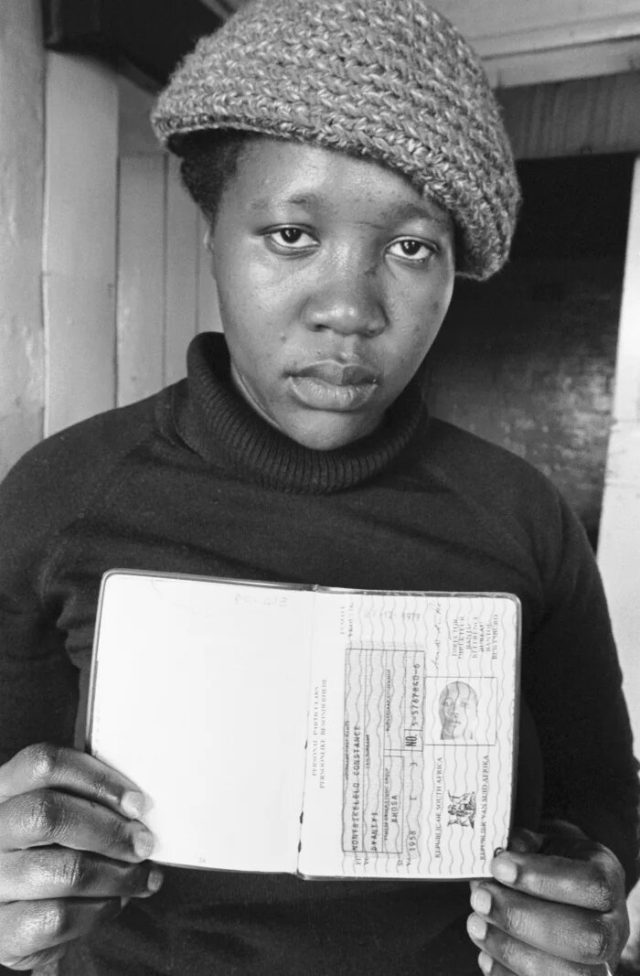
A woman shows the “interior passport” that she must have to enter Cape Town during work hours, circa 1984. The rest of the time, people of color were not allowed in the cities.
Those laws persisted through the 20th century as South Africa became a self-governing dominion of the United Kingdom. Between 1899 and 1902, Britain and the Dutch-descended Afrikaners fought one another in the Boer War, a conflict that the Afrikaners eventually lost. Anti-British sentiment continued to foment among white South Africans, and Afrikaner nationalists developed an identity rooted in white supremacy. When they took control in 1948, they made the country’s already discriminatory laws even more draconian.
Racist fears and attitudes about “natives” colored white society. Though apartheid was supposedly designed to allow different races to develop on their own, it forced black South Africans into poverty and hopelessness. “Grand” apartheid laws focused on keeping black people in their own designated “homelands.” And “petty” apartheid laws focused on daily life restricted almost every facet of black life in South Africa.
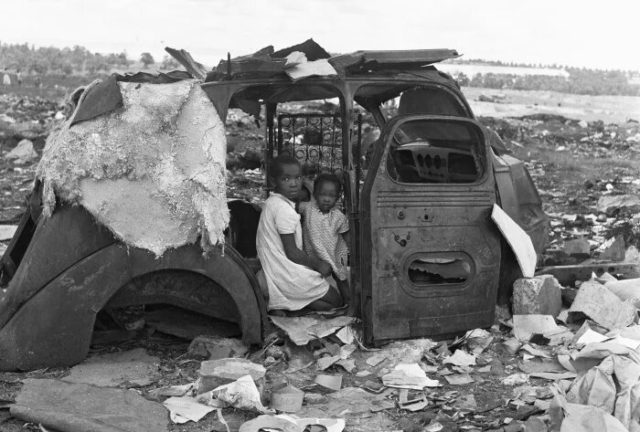
Children from the townships of Langa and Windermere scavenging close to Cape Town, in February 1955.
Pass laws and apartheid policies prohibited black people from entering urban areas without immediately finding a job. It was illegal for a black person not to carry a passbook. Black people could not marry white people. They could not set up businesses in white areas. Everywhere from hospitals to beaches was segregated. Education was restricted. And throughout the 1950s, the NP passed law after law regulating the movement and lives of black people.
Though they were disempowered, black South Africans protested their treatment within apartheid. In the 1950s, the African National Congress, the country’s oldest black political party, initiated a mass mobilization against the racists laws, called the Defiance Campaign. Black workers boycotted white businesses, went on strike, and staged non-violent protests.
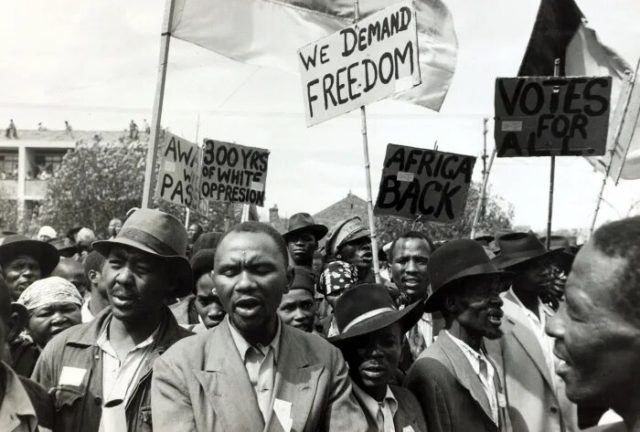
A crowd at a Johannesburg protest meeting which defied a ban on such gatherings, circa 1952.
These acts of defiance were met with police and state brutality. Protesters were beaten and tried en masse in unfair legal proceedings. But though the campaigns took a toll on black protesters, they didn’t generate enough international pressure on the South African government to inspire reforms.
In 1960, South African police killed 69 peaceful protesters in Sharpeville, sparking nationwide dissent and a wave of strikes. A subgroup of protesters who were tired of what they saw as ineffective nonviolent protests began to embrace armed resistance instead. Among them was Nelson Mandela, who helped organize a paramilitary subgroup of the ANC in 1960. He was arrested for treason in 1961, and was sentenced to life in prison for charges of sabotage in 1964.

30,000 protestors march from Langa into Cape Town in South Africa, to demand the release of prisoners in 1960. The prisoners were arrested for protesting against the segregationist pass laws.
In response to the 1960 protests, the government declared a state of emergency. This tactic cleared the way for even more apartheid laws to be put in place. Despite the state of emergency, black groups continued to organize and protest. But a crackdown on many movement leaders forced them into exile abroad.
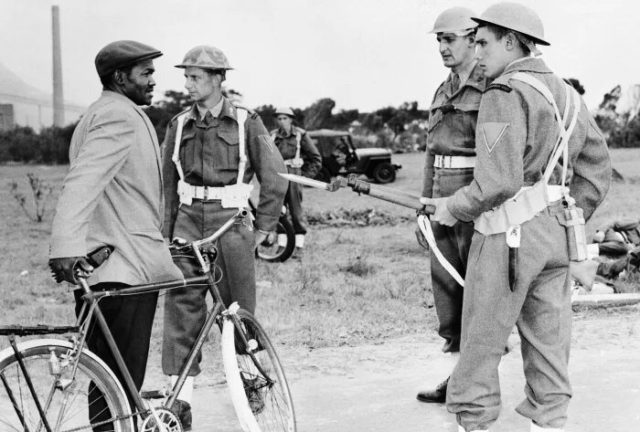
South African marines troops stopping a man in Nyanga, near Cape Town, in April 1960. Despite the state of emergency, black protestors tried to march to Cape Town to demand the release of black leaders, arrested after the Sharpeville massacre the month before.
Anti-apartheid protests continued as life for black South Africans became more and more dire under apartheid. On June 16, 1976, up to 10,000 black schoolchildren, inspired by new tenets of black consciousness, marched to protest a new law that forced them to learn Afrikaans in schools. In response, police massacred over 100 protesters and chaos broke out. Despite attempts to restrain the protests, they spread throughout South Africa. In response, exiled movement leaders recruited more and more people to resist.

Over 100 people were killed and more than 1,000 injured in South Africa following anti-apartheid protests in Soweto, near Johannesburg.
During the 1980s, resistance became even more fierce. Peaceful and violent protests finally began to spark international attention. Nelson Mandela, the movement’s most powerful and well-known representative, had been imprisoned since 1964. But he inspired his followers to continue resisting and conducted secret negotiations to end apartheid.
By the end of the 1980s, discontentment was growing among white South Africans about what they saw as South Africa’s diminished international standing. By then, the country faced sanctions and economic ramifications as international businesses, celebrities, and other governments pressured the government to end discrimination. As the economy faltered, the government was locked in a stalemate with anti-apartheid activists.
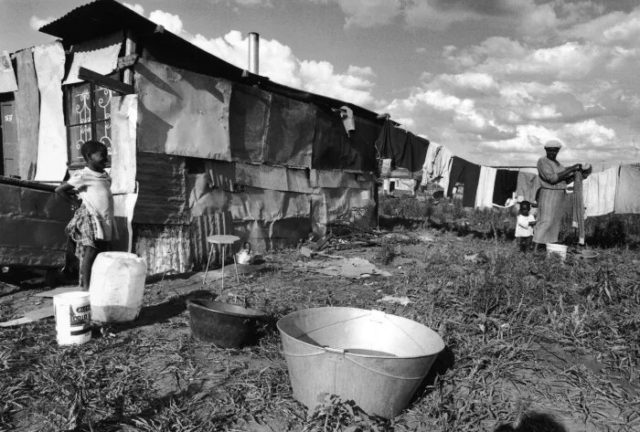
A South African family moved from Soweto to the Orange Farm shantytown in South Africa, December 1989.
But when South African president P.W. Botha resigned in 1989, the stalemate finally broke. Botha’s successor, F.W. de Klerk, decided it was time to negotiate to end apartheid in earnest. In February 1990, de Klerk lifted the ban on the ANC and other opposition groups and released Mandela, whose secret negotiations had thus far failed, from prison. Despite continued political violence, Mandela, de Klerk and their allies began intensive negotiations.
In 1994, the NP was finally defeated and Mandela became president of South Africa. A constitutional assembly was convened and South Africa adopted a new constitution that allowed for a South Africa that was not ruled by racial discrimination. It took effect in 1997.

Nelson Mandela, and seven other members of the anti-apartheid African National Congress, were sentenced to life imprisonment in 1964. 30 years later Mandela became the president of South Africa.
By then, South Africa had dismantled apartheid for good. Mandela and de Klerk won the Nobel Peace Prize in 1993 for their cooperation, and a truth and reconciliation commission began investigating human rights abuses and memorializing those abuses. The transition was not entirely non-violent. But by its end, South Africa had forged a new reality: one that owed its existence to the continued resistance of an oppressed racial majority.
